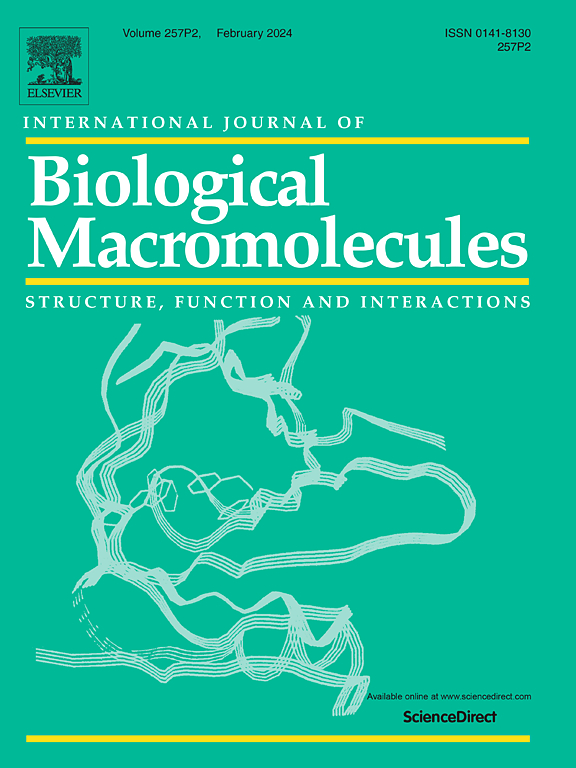Curcumin-loaded polyvinyl alcohol/nanocellulose/ nano zinc oxide nanofiber membranes with enhanced strength, moisture resistance, and antibacterial properties
IF 7.7
1区 化学
Q1 BIOCHEMISTRY & MOLECULAR BIOLOGY
International Journal of Biological Macromolecules
Pub Date : 2025-07-14
DOI:10.1016/j.ijbiomac.2025.145989
引用次数: 0
Abstract
To meet the practical application demands of nanofiber membranes (NFMs) under humid conditions, a PVA/NC/ZnO(S) NFM was successfully fabricated by incorporating nano zinc oxide (ZnO(S)) into a polyvinyl alcohol (PVA)/nanocellulose (NC) matrix, combined with nitrogen-assisted thermal treatment. The synergistic effect of ZnO(S)-induced heterogeneous nucleation and thermal processing significantly enhanced the crystallinity of the NFM (up to 49.71 %), improving its anti-swelling behavior and liquid absorption capacity—with an absorption rate of up to 1906 % for artificial blood. Building on this foundation, a dual-layer drug-loading strategy was developed by combining the PVA/NC/ZnO(S) NFM with hydroxypropyl-β-cyclodextrin (HP-β-CD) to encapsulate curcumin (Cur). The resulting drug-loaded NFM maintained excellent mechanical strength (29.17 MPa at a 1.5 % drug loading) and demonstrated favorable moisture resistance and antibacterial activity. Moreover, its in vitro drug release behavior could be finely tuned by adjusting the drug loading and external pH conditions. Overall, the synergistic enhancement and dual-encapsulation strategy proposed in this study provides an effective solution to the common challenges of swelling and instability in traditional drug carriers under wet conditions, and demonstrates promising potential in the design and application of biomedical wound dressings.

姜黄素负载聚乙烯醇/纳米纤维素/纳米氧化锌纳米纤维膜具有增强的强度,抗湿性和抗菌性能
为了满足湿润条件下纳米纤维膜(NFM)的实际应用需求,将纳米氧化锌(ZnO(S))掺入聚乙烯醇(PVA)/纳米纤维素(NC)基体中,结合氮辅助热处理,成功制备了PVA/NC/ZnO(S)纳米纤维膜。ZnO(S)诱导的非均相成核和热处理的协同作用显著提高了NFM的结晶度(高达49.71 %),提高了其抗膨胀性能和液体吸收能力,对人造血液的吸收率高达1906 %。在此基础上,建立了PVA/NC/ZnO(S) NFM与羟丙基-β-环糊精(HP-β-CD)包封姜黄素(Cur)的双层载药策略。得到的载药NFM在1.5 %载药量下保持了优异的机械强度(29.17 MPa),并表现出良好的耐湿性和抗菌活性。此外,它的体外释药行为可以通过调节载药量和外部pH条件来精细调节。综上所述,本研究提出的协同增强和双包封策略有效解决了传统药物载体在潮湿条件下肿胀和不稳定的共同挑战,在生物医学伤口敷料的设计和应用中具有广阔的潜力。
本文章由计算机程序翻译,如有差异,请以英文原文为准。
求助全文
约1分钟内获得全文
求助全文
来源期刊
CiteScore
13.70
自引率
9.80%
发文量
2728
审稿时长
64 days
期刊介绍:
The International Journal of Biological Macromolecules is a well-established international journal dedicated to research on the chemical and biological aspects of natural macromolecules. Focusing on proteins, macromolecular carbohydrates, glycoproteins, proteoglycans, lignins, biological poly-acids, and nucleic acids, the journal presents the latest findings in molecular structure, properties, biological activities, interactions, modifications, and functional properties. Papers must offer new and novel insights, encompassing related model systems, structural conformational studies, theoretical developments, and analytical techniques. Each paper is required to primarily focus on at least one named biological macromolecule, reflected in the title, abstract, and text.

 求助内容:
求助内容: 应助结果提醒方式:
应助结果提醒方式:


